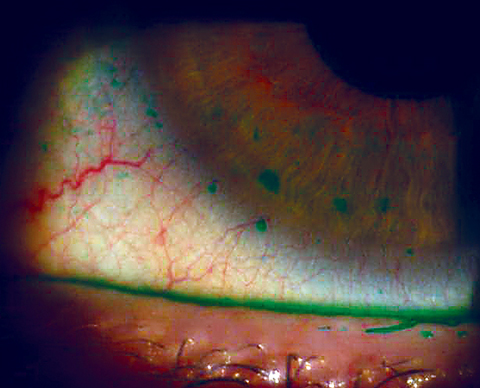 |
Worsening of dry eye symptoms was associated with increased screen time, corroborating previous findings suggesting that screen time can lead to increases in dry and uncomfortable eyes. Click image to enlarge. |
It goes without saying that COVID-19 changed the way individuals went about their daily lives, especially those who wear glasses and contact lenses. The abrupt lifestyle changes the pandemic wrought may have influenced a person’s spectacle and/or contact lens wearing habits, so in a new study, researchers sought to determine how vision correction habits changed after the pandemic onset. They found that hours per day of spectacle wear increased and days per week of contact lens wear decreased.
Participants documented vision correction habits, refractive error, screen time, mask wearing time and dry eye symptoms since the COVID-19 pandemic onset through an email survey. A total of 133 participants completed the survey. Among other things, they were asked, “Do you feel like your symptoms of eye dryness have worsened since March 2020?”
Increases in hourly spectacle wear were associated with increased screen time, while increased daily contact lens wear was associated with increased mask wear time, suggesting that glasses may be preferred for screen time activities and contact lenses during mask wear.
“For spectacle wearers, these results indicate the importance of patients having updated spectacles at home and work to optimize their visual and ocular comfort,” the researchers explained in their article on the work for Eye & Contact Lens. “For contact lens wearers, these results would encourage the use of a daily disposable modality, which is preferable for soft contact lens wearers who do not wear their lenses every day of the week, and suggest that those continuing to wear masks for long periods may prefer contact lens correction instead of spectacles.” Worsening of dry eye symptoms was associated with increased screen time, “corroborating existing evidence suggesting that screen time can lead to increases in dry and uncomfortable eyes,” they added.
Worsening dry eye symptoms were associated with increased days per week of glasses wear, but not with contact lens–wearing habits. Such symptoms were not associated with mask wear time, but the authors noted that mask-associated dry eye has become a topic of interest since COVID-19 required many people to initiate mask wear, often for extended periods.
“Mask-associated dry eye has been described as a condition where dry eye symptoms present with and become worse while wearing a mask,” the authors explained of previous studies. “Mask-associated dry eye is believed to occur when masks fit too loose (causing air to flow up toward the eyes, increasing tear evaporation or too tightly (pulling down on the lower lid and interfering with proper blink function).”
The authors noted that there was no objective measure of dry eye symptoms severity pre-pandemic or post-pandemic onset, so they should be interpreted with caution and understanding of that limitation. “Perhaps, if a standardized survey were used, more detailed conclusions could be made.”
The number of participants reporting dry eye symptoms was 38.3%, and worsening dry eye symptoms were associated with increased reported screen time. Symptoms of dry eye and ocular discomfort are commonly reported with digital device use and referred to as “digital eye strain.”
“Potential for an increase in symptoms of dry eye and digital eye strain has been a particular topic of concern during the pandemic when so many people experience increased screen time demands,” the authors explained. “In this study, screen time increased significantly since pandemic onset by about three hours and worsening dry eye symptoms were associated with this change.”
Rueff EM, Chen EY, Nguyen AL. Vision correction habits after COVID-19 onset in spectacle and contact lens wearers. Eye & Contact Lens. October 28, 2023. [Epub ahead of print.] |

